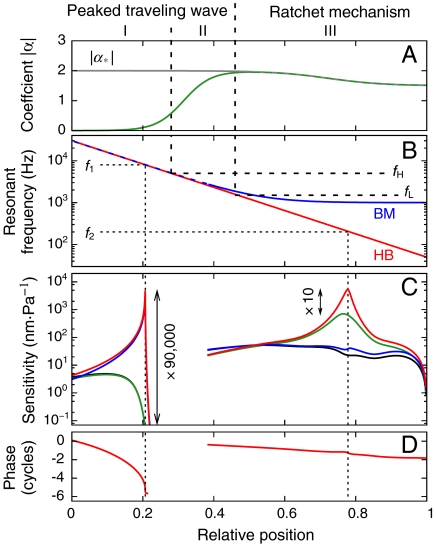Fig. 3.
Cochlear model. (A) The ratchet mechanism operates when the mechanomotility coefficient α (Green) coincides with the critical value α∗ (gray). Although electromotility is negligible to the basal side of fH, it underlies the ratchet mechanism apical to the position of fL. (B) The resonant frequency of the hair-bundle complex (HB, Red) agrees with that of the basilar membrane (BM, Blue) only for frequencies above fL. (C) A high-frequency sound stimulus (f1 = 8 kHz) induces a traveling wave that peaks in the basal region. The displacements of the hair bundles (Red) coincide with that of the basilar membrane (Blue). Elimination of active hair-bundle motility decreases the sensitivity by a factor of 90,000 (Green, hair bundles; Black, basilar membrane) indicative of a strong nonlinearity. A low-frequency stimulus (f2 = 200 Hz) triggers a traveling wave that does not peak on the basilar membrane, but the hair-bundle displacement exhibits a resonance enabled by the ratchet mechanism (same color code). Without active hair-bundle motion the hair-bundle displacement decreases by a factor of only 10, indicative of a weak nonlinearity. (D) The phase of the basilar-membrane displacement for f1 has a strongly increasing slope near the resonant position and thus shows a wave traveling to the resonant position but not beyond. For f2 the slope of the phase remains almost constant, corresponding to a wave traveling beyond the characteristic place.

